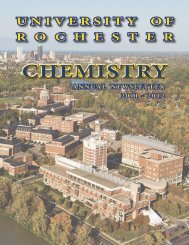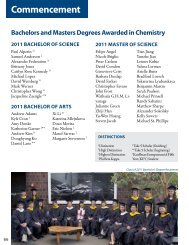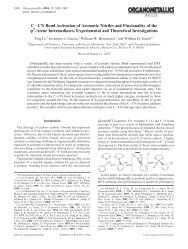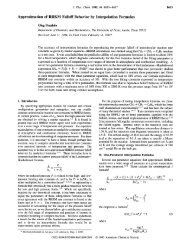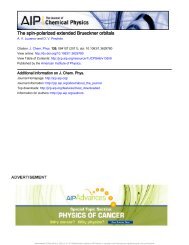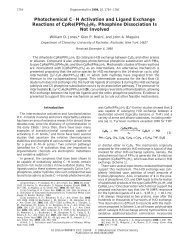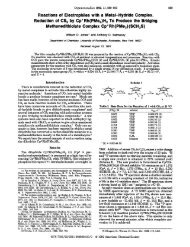ch 41.2.2-kadosh - Chemistry
ch 41.2.2-kadosh - Chemistry
ch 41.2.2-kadosh - Chemistry
You also want an ePaper? Increase the reach of your titles
YUMPU automatically turns print PDFs into web optimized ePapers that Google loves.
2<br />
The first step in the complex ET dynamics of the<br />
Graetzel cell is the ultrafast ET to the semiconductor<br />
from the atta<strong>ch</strong>ed molecular donor. The rate and me<strong>ch</strong>anism<br />
of this ultrafast ET are currently under active<br />
experimental 5,16–29 and theoretical 30–36 investigation. Recently,<br />
ET on a record femtosecond timescale has been<br />
reported. A femtosecond laser study of alizarin-sensitized<br />
TiO 2 revealed ET with a 6-fs injection time, 18 and a<br />
resonant photoemission study of bi-isonicotinic acidsensitized<br />
TiO 2-determined ET with an injection time of<br />
less than 3 fs. 25 Coherent oscillations in both the ET<br />
coordinate and the vibrational wave-packet motion of<br />
the ET product were seen under ultra-high vacuum<br />
(UHV). 6,28,29 No redistribution of the vibrational excitation<br />
energy can be expected at su<strong>ch</strong> ultrafast timescales, 6,28<br />
making it difficult to invoke the traditional Marcus–<br />
Levi<strong>ch</strong>–Jortner–Geris<strong>ch</strong>er 37–40 ET me<strong>ch</strong>anism, as well<br />
as the modern analytical and computational reaction rate<br />
theories. 30,41–49<br />
Two competing me<strong>ch</strong>anisms, whi<strong>ch</strong> can be differentiated<br />
as shown in Fig. 1, and whi<strong>ch</strong> require different<br />
conditions for optimum performance, have been proposed<br />
to explain the observed ultrafast ET between the<br />
dye and the semiconductor. 13,15 When the coupling is<br />
sufficient to induce a large splitting between the donor<br />
and acceptor state, so that the electron remains in the<br />
same adiabatic state as the system passes through the<br />
transition region, the me<strong>ch</strong>anism is adiabatic. In this<br />
case the ET occurs via redistribution of the electron<br />
density of the adiabatic state due to ionic motion, and<br />
the rate may be estimated using transition state<br />
theory. 50,51 If the coupling is sufficently small and the<br />
Fig. 1. Adiabatic and nonadiabatic pathways of electron transfer.<br />
In adiabatic ET (solid bold line) the electron remains in the<br />
same adiabatic state throughout the reaction, proceeding from<br />
the reactant state to the product state through the transition<br />
state. In nonadiabatic ET, the electron proceeds from the reactant<br />
state to the product state via a direct transition (bold dotted<br />
and dashed lines).<br />
Israel Journal of <strong>Chemistry</strong> 42 2002<br />
system passes through the transition region remaining in<br />
the same diabatic state and <strong>ch</strong>anging its adiabatic state,<br />
the ET is nonadiabatic (NA). NA ET occurs through a<br />
direct transition from the dye state to a manifold of<br />
acceptor states, and the rate could be calculated using<br />
standard Landau–Zener theory. 52 In experimental work<br />
the me<strong>ch</strong>anism must be deduced from observables su<strong>ch</strong><br />
as the reaction rate. For example, in cases where the<br />
Marcus theory of ET is applicable, the distinction between<br />
NA or adiabatic ET may be inferred from the rate<br />
equation<br />
(1)<br />
in whi<strong>ch</strong> the transmission factor κ should be approximately<br />
unity for adiabatic reactions and mu<strong>ch</strong> less than<br />
one for NA reactions. 50<br />
Whi<strong>ch</strong> me<strong>ch</strong>anism is at work is a practical concern<br />
because of design implications. NA transfer relies on a<br />
high density of states in the conduction band. Since the<br />
density of states increases with energy, 53 an increase of<br />
the <strong>ch</strong>romophore excited state energy relative to the<br />
edge of the conduction band will accelerate the transfer.<br />
At the same time, the photoexcitation energy and voltage<br />
will be lost due to the relaxation of the injected<br />
electron to the bottom of the conduction band. In the<br />
event of NA ET, it is also important to minimize <strong>ch</strong>romophore<br />
intramolecular vibrational relaxation, 54,55<br />
whi<strong>ch</strong> lowers the <strong>ch</strong>romophore energy and thereby the<br />
accessible density of conduction band states. NA ET is a<br />
purely quantum me<strong>ch</strong>anical process with many tunneling<br />
features. In particular, the rate of NA ET will decrease<br />
exponentially with increasing distance between<br />
the donor and acceptor species. Efficient NA ET requires<br />
short donor–acceptor bridges. Conversely, the<br />
adiabatic ET rate will be mu<strong>ch</strong> more weakly dependent<br />
on the density of acceptor states and will not exponentially<br />
decay with longer bridges. Since adiabatic transfer<br />
requires an energy fluctuation that can bring the system<br />
to the transition state, a fast ex<strong>ch</strong>ange of energy between<br />
vibrational modes of the <strong>ch</strong>romophore will increase the<br />
likelihood of adiabatic ET.<br />
Our first simulation of the ET was carried out at low<br />
temperature 34 to reflect UHV experimental conditions.<br />
6,28,29 The simulation revealed that the earliest ET<br />
was dominated by the NA me<strong>ch</strong>anism, with significant<br />
contributions from the adiabatic me<strong>ch</strong>anism at the later<br />
stages. It was found that the ET was localized to the first<br />
3 layers of the surface, with a single Ti atom closest to<br />
the <strong>ch</strong>romophore contributing over 20%. The simulation<br />
predicted a complex non-single-exponential time<br />
dependence of the ET process. In the current study, the








